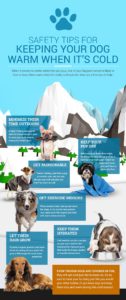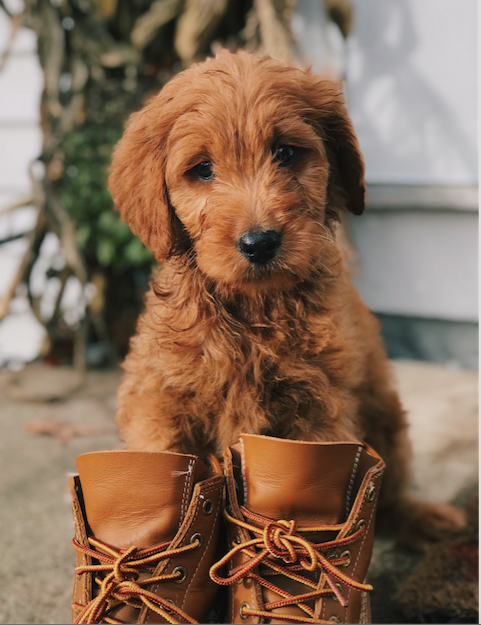Daily walks keep dogs happy and healthy, but if the temperature drops below 30° F it’s not safe for dogs to be outside for long, especially smaller breeds. In extreme weather you can exercise your dog by playing with toys indoors, but sometimes dogs will be happy to go for walks in snow and cold temperatures, you just need to take some precautions to keep them safe, warm and comfortable.
Don’t Leave Dogs In Cars
It’s common knowledge to not leave dogs in a car on a hot day, but the same applies for cold weather too. Cars can quickly drop in temperature in the winter, acting as a refrigerator, so you should never leave dogs in them, even for a few minutes. Some dogs are more susceptible to the cold, mainly smaller breeds with short hair and if they have respiratory or heart problems they’ll struggle to regulate their body temperature. When travelling with your dog you can help to warm your car up by running the engine for a few minutes before getting in and putting the heat on or use an in-car heater to speed things up.
Dog Booties
 Clothes look adorable on dogs and most owners will have sweaters or waterproof coats to keep their dogs warm and dry in cold weather. However, booties are not as common, but serve an important purpose. Booties will protect dogs paws from rock salt and other antifreeze that is spread onto roads and sidewalks to accelerate snow melting, which can irritate dogs paws and skin. Booties will often need breaking in for your pup as they will feel strange having something on their feet. Get them used to wearing them for a few minutes around the home and gradually built this up until they’re comfortable wearing them on walks.
Clothes look adorable on dogs and most owners will have sweaters or waterproof coats to keep their dogs warm and dry in cold weather. However, booties are not as common, but serve an important purpose. Booties will protect dogs paws from rock salt and other antifreeze that is spread onto roads and sidewalks to accelerate snow melting, which can irritate dogs paws and skin. Booties will often need breaking in for your pup as they will feel strange having something on their feet. Get them used to wearing them for a few minutes around the home and gradually built this up until they’re comfortable wearing them on walks.
Dog Clothing
Just as there are lots of different clothing items for dogs large and small- be sure to pick a variety of clothing items such as multiple sweaters, vets and jackets. If you are in a colder weather climate location, purchasing multiple of each item is recommended as they will need to be regularly washed. Be sure to remove clothing that was used outside as you don’t want the dog to be wearing a damped sweater or jacket inside. Be sure to brush your dog’s furr before and after with a dematting comb as to reduce the chances of the furr lumping together. Many dog owners skip this step and it results in their dogs fur getting clumped together which causes discomfort for the dog as the fur pulls against the skin.
Lakes, Rivers And Streams
When going for a walk with your dog it can be tempting for both you and your dog to skate and slide on frozen lakes, rivers and streams. This can be good fun, especially watching your pooch try to keep their balance, but it isn’t advised as it can be very dangerous. Not only is there a risk of falls and injuries, it’s difficult to tell how thick and secure the ice is and if it will hold the weight of you and your dog. Don’t let dogs swim in water when it’s cold either as it will be difficult to warm them back up and could make them ill.
At Home Precautions:
When you do come home from being outdoors, it is imperative that you towel dry your dog especially under their belly and around their legs and paws (don’t forget the between the paw pads) to remove any icicles that may have attached to their fur or skin. Look for any cracks or redness that may have resulted from being outdoors.
Do keep your home humidified as excessive dry heat leaves their skin/coat succiptable to irritation and dryness which can make skin abrasions etc more likely to occur.
Dogs require more energy to keep themselves warm in the winter. Just as humans tend to double down and become less active in the winter, so too is the case for some dogs. You can also feed them more in the winter as it can provide more calories burned for them to keep warm.
A Word of Caution for Suburban dogs:
Beyond the obvious shivering and refusing to want to walk, dogs may show signs of disorientation/confusion which can result in becoming lost. If left outside even if just to run outside to relieve themselves, they can become lost, get stolen or hit by a vehicle.
Keeping your furry best friend warm in the winter will also keep them healthy and happy. Give your dog sweaters and coats to keep them warm in colder temperatures and never leave them outside in extreme weather. Be sure to brush their hair regularly, and add a conditioning product to their air to avoid matting! Always keep them on a lead during walks and watch them closely to avoid them from consuming harmful antifreeze.
This article was contributed by Jane Wood with the pet winter safety tips infographic contributed by https://www.aspenautomail.com/.




